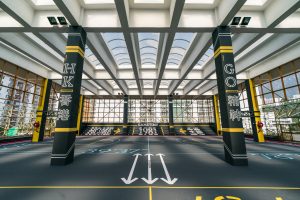ESG is a key value creation lever, says Gaw Capital’s Christina Gaw
It comes as no surprise that responsible practices and ESG investing have increasingly come under the spotlight, with sustainability evolving from a “nice-to-have” theme to an important driving force of our industry’s recovery and growth. Being committed to ESG is no longer about checking boxes but instead taking a holistic focus on its three key pillars – environmental, social and governance – and their integration with businesses.
At Gaw Capital, we see ESG as a crucial part of real estate investment. Only through understanding ESG risks and opportunities can we develop resilient assets that will deliver longterm value to our investors.
According to a survey by PwC on global private equity responsible investment, 66 percent of respondents rank value creation as one of their top three drivers of responsible investing or ESG activity. The interest of our investors is always our top priority, so understanding ESG and safeguarding our portfolio against future risk are of utmost importance.
LPs in the new era are looking for managers with profound understanding of ESG and the ability to integrate and implement it into the investment lifecycle. This includes evidence of robust governance structure, how fiduciary duty is performed and ESG disclosure transparency, to name a few.
To fully integrate ESG with our business in a holistic way, we always start by understanding the underlying risks and opportunities.
At the pre-investment stage, we incorporate an ESG checklist in line with international frames such as GRESB and PRI as due diligence on potential assets. It is crucial for us to map out our business plans and investment decisions to verify that they align with our investment and sustainability goals.
There is no “one-size-fits-all” approach to this; the ESG integration for an office building in Japan would be different from a data center in Vietnam. Whereas both sites may use the same analytics and load management SaaS to monitor performance and reduce energy spending, the data center asset would likely require more detailed real time analytics, a customized monitoring dashboard and additional battery units to store backup energy.
Successful ESG integration requires great knowledge and sophistication to chart the right course. Therefore, we have established a Sustainability Committee to oversee ESG risks and opportunities under our business operations, as well as a devoted team to keep daily operations on track with our strategies. As part of this progression, we are also actively engaging stakeholders on ESG-related initiatives and communicating with investors to better facilitate their ESG agenda.
Case Study
Community engagement through People’s Place
From a sustainability perspective, community engagement is an area we highly value and are proud of. Our approach to community engagement has created tremendous value, by not only creating positive social uplift in our communities but also through its alignment with economic profits.
By serving the community, we create a sustainable ecosystem that supports businesses with the community’s buy-in. People’s Place is a good illustration of this philosophy.
In 2018 and 2019, we acquired 29 community malls in Hong Kong that are surrounded by subsidized public housing and have been around for over 40 years. We saw the opportunity to rejuvenate these communities through placemaking initiatives.
Our work for People’s Place started with Kai Yip Shopping Centre, where we renovated the obsolete rooftop into the first local estate recreation center to win an international architectural award. As one of Hong Kong’s hottest and most Instagram-able sports grounds, it attracts outsiders to join the community.
To encourage community engagement, we brought together a group of social designers and street basketball players, the actual end-users of the space, to jointly design and create a hub that resonates best with the community. We also partnered with local charity InspiringHK Sports Foundation to host the public estate basketball league and training program called Well Dunk. By offering local youths the venue for basketball training and competition, the program successfully subsidized the creation of local basketball teams in different public estates.
Over the years, we have renovated eight recreation facilities around People’s Place, and the value created is shared by their local communities. Today the community engagement around these facilities attracts a plethora of corporate sponsors, such as sports brand Nike, energy drink giant Red Bull and Hennessy, official spirit of the NBA, a testament to how social engagement drives more vibrant communities.
In a packed city like Hong Kong, our sports grounds opened a window for locals to escape from the confinement of their homes, while also driving foot traffic for our tenants and local businesses, tying together the value chain of our platform. We are thrilled to see how these small seeds of change can generate such positive lasting impacts for our local communities.
Addressing climate risk
Over the past few years, we have realized the existential risks posed by climate change and decarbonization are inevitably among the most material topics in the real estate industry that must be solved with commitment and devotion. As governments of various nations take increasingly aggressive action to address climate change and fulfill their targets for net zero, climate-related regulation is expected to tighten. The real estate sector, which accounts for 40 percent of global carbon emissions, is therefore destined to play an essential role in decarbonization worldwide.
At Gaw Capital, we are dedicated to hedging against future transition risks by reducing carbon emissions in our portfolio today. For existing assets, our focus lies in the reduction of operational carbon through the installation of energy-efficient appliances and the utilization of renewable energy. We have rolled out solar panel installation programs on the roofs of commercial buildings, community malls and warehouses in our portfolio.
For example, at People’s Place, nearly 50 percent of the malls have solar panels installed, which in turn empower the numerous EV charging stations deployed across its carparks, fulfilling the environmental aspect of ESG by supporting Hong Kong’s transition towards greener mobility.
For new-build assets, we are targeting carbon emissions across the asset lifecycle. We aim to integrate sustainability into the building design, construction and operations, including advocating for green design principles, achieving green building certifications, working with ESG-conscious contractors and operators, promoting green construction methods and implementing sustainable operating practices.
Our understanding of ESG has also revealed new opportunities in sustainable investing and driven our conviction in renewable energy-focused private equity deals. As an example, we recently partnered with Maoneng, an Australian developer, owner and operator of clean energy assets, to build utility-scale battery energy storage systems (BESS).
This new BESS infrastructure is critical to providing fast response dispatchable energy to facilitate load balancing, frequency control and to help reduce electricity costs. By building out more BESS through this investment, we can support Australia’s transition to clean energy by allowing the National Electricity Market to accommodate ever-increasing levels of variable renewable energy in the generation mix, both to address growing consumer demand and to replace retiring coal-fired generators.
Our IDC platform presents another excellent example of how we integrate ESG into the value chain. As a niche and high-tech asset class, data centers are traditionally known as being carbon intensive. Some of our tenants, especially the hyperscalers, have made pledges towards carbon neutrality in the near future. We are also closely monitoring energy and water consumption through automated meters as well as installing wall and roof insulation to ensure optimal energy efficiency.
Successful integration relies heavily on sector-specific technical solutions and equipment, as well as talent that understands the value chain. We will continue to explore low-carbon data centers with innovations and new products brought by the rise of data centers.
As these projects have shown, the distinction between classic real estate and sustainability, traditional and renewable infrastructure, proptech and climate tech is evaporating right before our eyes. The responsibility of creating a more sustainable future thus lies on the asset managers of today. Gaw Capital is committed to being part of the global sustainable solution and will continue to align these verticals to initiate positive change.
“The distinction between classic real estate and sustainability, traditional and renewable infrastructure, proptech and climate tech is evaporating”
A sustainable future
Incorporating ESG considerations into our investment strategies is not without challenges, but we are not alone on this journey. As we strive to achieve sustainability, banks are also tapping into the market of green finance and green loans. By adopting green loans, we also play a part in supporting the development of a more sustainable capital market globally.
As banks prioritize responsible banking, the development of green loans is thriving. Banks now have their own sustainable finance framework to provide guidance on eligibility criteria for green loans and a credit underwriting framework to facilitate green finance.
Our first green loan was in 2019 when we acquired DUO Tower and DUO Galleria in Singapore, during which DBS, Standard Chartered and United Overseas Bank teamed up to provide a S$945 million ($667 million; €665 million) green loan for the acquisition. Since then, we have been adopting green loans in our projects such as 1111 King’s Road, 12 Tai Koo Wan Road, and 14 Tai Koo Wan Road, in Hong Kong and the four premium office buildings at Shanghai MixC. We will continue the pursuit of sustainable operation and firmly believe the trend of using green loans will continue as sustainability has become a topic in the capital market that is too good to miss.
One thing we learnt in the past few years is that digitalization is inevitable. We strongly believe that staying agile and tech-savvy is crucial to sustainable development. Take as an example one of our portfolio companies, Switch Automation, an automated real estate SaaS platform that integrates with traditional building systems to collect and analyze data, monitor and control assets in real time, improve tenant satisfaction and reduce overall building energy usage.
Switch Automation provides us with actionable insights on how to make our assets more efficient from both an energy saving and ROI perspective. These sustainable technologies have strong synergies with our wider real estate portfolio and have become increasingly important to building greener environments that drive long-term value.
As digitization accelerates within real estate, it is inevitable that the risk of data breaches also increases in parallel. Furthermore, the shift to remote working also increases the need for improved digital practices, thus putting cybersecurity front and center in supporting sustainable real estate governance. Gaw Capital is committed to improving governance across its assets and portfolio companies and is therefore an active investor in this space.
The sustainability journey of our industry still has a long way to go and we are holding ourselves accountable to a greener future. We will continue the ESG integration of our business to better position ourselves for the upcoming wave of sustainability. Let’s join forces to make a difference and build a brighter, greener future.
Source: PERE





 Gaw Capital Partners, through its funds under management, and its consortium partners, acquired 29 Hong Kong-based community shopping centers and associated facilities in March 2018 and March 2019.
Gaw Capital Partners officially started to operate over 29 assets and facilities near the public estates and established “People’s Place”. “People” stands for the public and the residents, whereas “Place” here is an allusion to the idiomatic Chinese term for a location of virtue and tradition, as well as a well-governed community; “Place” also connotes the solidarity of the local neighborhood. All in all, “People’s Place” stands for a place rich in sentiments and compassion, bringing strangers together in constructing a vibrant, cozy living environment. People’s Place aspires to transform obsolete commercial facilities into vibrant community hubs by creatively utilizing its space and bringing brand new experiences to residents, tenants and community stakeholders.
Gaw Capital Partners, through its funds under management, and its consortium partners, acquired 29 Hong Kong-based community shopping centers and associated facilities in March 2018 and March 2019.
Gaw Capital Partners officially started to operate over 29 assets and facilities near the public estates and established “People’s Place”. “People” stands for the public and the residents, whereas “Place” here is an allusion to the idiomatic Chinese term for a location of virtue and tradition, as well as a well-governed community; “Place” also connotes the solidarity of the local neighborhood. All in all, “People’s Place” stands for a place rich in sentiments and compassion, bringing strangers together in constructing a vibrant, cozy living environment. People’s Place aspires to transform obsolete commercial facilities into vibrant community hubs by creatively utilizing its space and bringing brand new experiences to residents, tenants and community stakeholders.  In partnership with experienced educators in China, Gaw Capital has invested in the development and operations of Stellart International School of Arts (SISA), an international arts education platform in China. The platform is initially seeded by a commercial site conveniently located in Sanshan New Town in Nanhai, Foshan, which has excellent connectivity nationally via the Guangzhou South Station. The site has a GFA of c.50,000 sqm in total. Operating under the SISA brand and developed by Gaw Capital Partners, the school houses up to 600 full-time high school students in its 6-storey tall academic block and 7-floor dormitory.
In partnership with experienced educators in China, Gaw Capital has invested in the development and operations of Stellart International School of Arts (SISA), an international arts education platform in China. The platform is initially seeded by a commercial site conveniently located in Sanshan New Town in Nanhai, Foshan, which has excellent connectivity nationally via the Guangzhou South Station. The site has a GFA of c.50,000 sqm in total. Operating under the SISA brand and developed by Gaw Capital Partners, the school houses up to 600 full-time high school students in its 6-storey tall academic block and 7-floor dormitory. 

